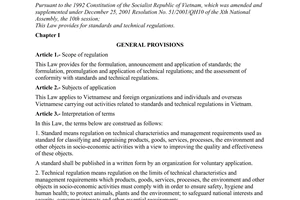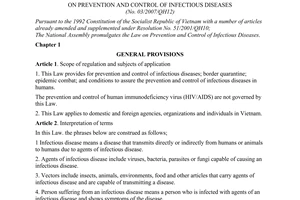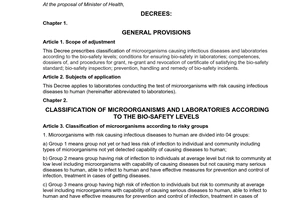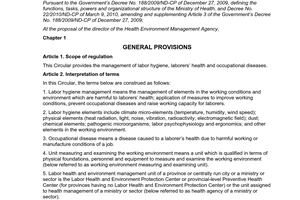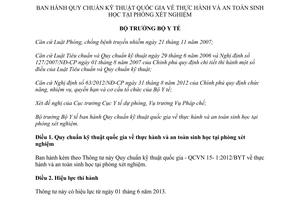Circular 25/2012/TT-BYT national technical regulation on practice and biosafety in laboratories đã được thay thế bởi Circular 37/2017/TT-BYT on biosafety in laboratories và được áp dụng kể từ ngày 15/12/2017.
Nội dung toàn văn Circular 25/2012/TT-BYT national technical regulation on practice and biosafety in laboratories
|
MINISTRY OF
HEALTH |
SOCIALIST
REPUBLIC OF VIETNAM |
|
No: 25/2012/TT-BYT |
Hanoi, November 29, 2012 |
CIRCULAR
PROMULGATING NATIONAL TECHNICAL REGULATION ON PRACTICE AND BIOSAFETY IN LABORATORIES
THE MINISTER OF HEALTH
Pursuant to the Law on prevention and treatment of infectious diseases dated November 21, 2007;
Pursuant to the Law on Technical regulations and standards dated June 29, 2006 and the Government's Decree No. 127/2007/NĐ-CP dated August 01, 2007 detailing the implementation of a number of articles of the Law on Technical regulations and standards;
Pursuant to the Government's Decree No. 63/2012/NĐ-CP dated August 31, 2012 defining the functions, tasks, powers and organizational structure of the Ministry of Health;
At the request of the Director of Department of Preventive Medicine, the Director of the Legal Department;
The Minister of Health promulgates national technical regulation on practice and biosafety in laboratories.
Article 1. National technical regulation on practice and biosafety in laboratories
National technical regulation-QCVN 15- 1:2012/BYT on practice and biosafety in laboratories is enclosed herewith this Circular.
Article 2. Effect
This Circular takes effect from June 1, 2013.
Article 3. Responsibility for implementation
Director of Department of Preventive Medicine, heads of units under the Ministry of Health, the units directly under the Ministry of Health, Directors of the Department of Health in central-affiliated cities and provinces and related organizations, individuals shall be responsible for the implementation of this Circular. /.
|
|
MINISTER |
QCVN 15- 1: 2012/BYT
NATIONAL TECHNICAL REGULATION ON PRACTICE AND BIOSAFETY IN LABORATORIES
(Enclosed herewith the Minister of Health’s Circular No. 25/2012/TT-BYT dated November 29, 2012)
Preface
QCVN 15-1: 2012 / BYT is compiled by the Department of Preventive Medicine -the Ministry of Health; verified by the Ministry of Science and Technology and issued by the Ministry of Health under the Minister of Health’s Circular No. 25/2012 / TT-BYT dated November 29, 2012.
TABLE OF CONTENTS
Part I: GENERAL PROVISIONS
I. SCOPE OF REGULATION AND REGULATED ENTITIES
II. INTEPRETATION OF TERMS
Part II: TECHNICAL REGULATIONS
I. BIOSAFETY LABORATORIES LEVEL I
II. BIOSAFETY LABORATORIES LEVEL II
III. BIOSAFETY LABORATORIES LEVEL III
IV. BIOSAFETY LABORATORIES LEVEL IV
Part III: IMPLEMENTATION
NATIONAL TECHNICAL REGULATION ON PRACTICE AND BIOSAFETY IN LABORATORY
National technical regulation on practice and biosafety in laboratories
Part 1.
GENERAL PROVISIONS
I. SCOPE OF REGULATION AND REGULATED ENTITIES
- National technical regulation on practice and biosafety in laboratories defines facilities equipment, personnel and practices to ensure biosafety in laboratories;
- National technical regulation on practice and biosafety in laboratories shall be applied to laboratories testing microorganisms that are likely to cause infectious diseases in humans.
II. INTEPRETATION OF TERMS
In this regulation, the following terms are construed as follows:
- Decontamination: is the process of removing, destroying microorganisms; removing or neutralizing hazardous chemicals and radioactive substances. Decontamination process includes cleaning, disinfection and sterilization carried out based on safety requirements and the actual conditions of each laboratory.
- Cleaning: means removal of dust and chemicals in the laboratories by using water, detergents and cleaning chemicals.
- Disinfection: is the process of eliminating almost all pathogenic microorganisms except bacterial spores.
- Sterilization: means cutting off all forms of microorganism life, including spores.
- Laboratory staff: includes all those working in the laboratories as laboratory curators, testers or decontaminating persons .
Part 2.
TECHNICAL REGULATIONS
I. BIOSAFETY LABORATORIES LEVEL I
1. Facilities of laboratories
Biosafety laboratories level I must meet the provisions of Paragraph 1 of Article 5 of the Government's Decree No. 92/2010 / ND-CP dated August 30, 2010 and the following provisions:
a) Technical requirements for doors and windows:
- Doors: have architrave, bolts, safety locks; doors made of wood or synthetic materials or metal combined with clear glass.
- Windows: have architrave, safety bolts; windows made of wood or synthetic materials or metal combined with clear glass or blurred glass to light naturally.
b) Technical requirements for floors, walls and ceilings of laboratories:
- Floors:
Have no difference in floor levels , no ledge and be even, smooth, non-slip, resistant to chemicals, waterproof and easy to wash and clean;
In the sterile wash room, when preparing environment or samples, have a water collecting place when cleaning;
In the intersection line of floors and walls, be easy to clean and against stagnant water.
- Walls: Be smooth, easy to clean, waterproof and resistant to chemicals commonly used in laboratories.
- Ceilings: Be flat, smooth, waterproof and installed equipment (lighting, fire prevention and fighting, air conditioners or other equipment).
c) Testing table surface: Be waterproof, resistant to disinfectant solutions, acids, alkalis, organic solvents and thermotolerant.
d) Room for clothing and personal items for personnel: be outside the laboratory and room for hanging laboratory coat shall be inside, close to the laboratory doors;
dd) The laboratories: Ensure sufficient light for operation. The light in the test area shall have a minimum illuminance of 400 lux, in the washed, sterilized, sample preparation, environmental, bathing, dressing areas shall be 250 lux, in administrative and auxiliary areas shall be 140 lux;
e) Emergency eyewash equipment and first-aid box: Be placed in a favorable position for use;
g) Electricity system: ensure safety in accordance with national standards:
- There are alternative power sources;
- The system of wires and control equipment, power supply must ensure safe and appropriate technical parameters (capacity, quality);
- There are overload protection systems;
- The entire system must be connected to ground;
- Sockets must be higher than the laboratory ground at least 40cm, not close to taps;
h) Areas with ultraviolet rays, lasers, radioactive substances, toxic substances must have corresponding signs;
i) There are fire protection and fighting equipment as prescribed.
2. Laboratory equipment
Biosafety laboratories level I must meet fully the requirements of Paragraph 2 of Article 5 of the Government's Decree No. 92/2010 / ND-CP dated August 30, 2010 and the following provisions:
a) Equipment must have the appropriate information labels such as: name, serial number, use date, check status, calibration; equipment résumé and manuals;
b) When operating, equipment must meet the technical parameters given by manufacturers.
3. Laboratory personnel
Biosafety laboratories level I must meet the provisions of Paragraph 3 of Article 5 of the Government's Decree No. 92/2010 / ND-CP dated August 30, 2010 and the following provisions:
a) Number of employees: have at least 02 employees;
b) must be examined and monitored health as prescribed in the Minister of Health’s Circular No. 19/2011 / TT-BYT dated June 6, 2011 on guidance on labor hygiene management of worker health and occupational diseases before and during work in the laboratory;
c) Be trained in labor safety, fire prevention and fighting;
d) Be trained annually on testing and biosafety as stipulated in the Minister of Health’s Circular No.07 / 2008 / TT-BYT dated May 28, 2008 on the continuously training guidance for health staff.
4. Practice regulations
Regulations on coming in and out laboratories: Only responsible persons shall be allowed to come into the laboratories.
Regulations on safe practices in laboratories
a) Have and comply with testing procedures, use instructions of equipment and waste treatment process;
b) Do not use mouth with pipette;
c) Do not use syringe and tubular needles to replace the pipette or in any purposes other than the purpose of injection, transfusion and suck fluid from laboratory animals; syringe and tubular needles after use must be put into specialized sharp containers or automatic cancelation machine, do not bend, break, cover the tubular needle cap or remove the tubular needles from the syringes;
d) Wash exposed skin with chemicals, wash hands before leaving the laboratory;
dd) Wear protective clothing, closed-toe shoes while working in the laboratories, do not wear protective clothing in the public sectors;
e) Do not put protective clothing with regular clothing;
g) Do not bring personal items and food to the laboratories;
h) Do not use laboratory equipment to store or process food;
i) Do not eat, drink, smoke, shave and use cosmetics in the laboratories.
Decontamination and waste treatment
a) Working desk surface must be decontaminated immediately after the end of the test, at the end of working day or when there is a spill, pour pathology specimens containing pathogens;
b) Waste must be classified, transported and treated as prescribed.
5. Prevention, handling and remediation of biosafety problems
The requirements of Articles 518, 19 of the Government's Decree No. 92/2010 / ND-CP dated August 30, 2010 and the following provisions must be met fully:
a) Have problem handling process;
b) Keep a record of problems and handling measures for the problems at least 3 years.
II. BIOSAFETY LABORATORIES LEVEL II
1. Facilities of laboratories
Biosafety Laboratories level II must fulfill the regulations on the facilities of the biosafety laboratories level I and the provisions of Paragraph 1 of Article 6 of the Government’s Decree No. 92/2010 / ND CP dated August 30, 2010 and sewage treatment systems meeting QCVN 28: 2010 / BTNMT of the Ministry of Natural Resources and Environment on medical wastewater before discharge into the general drainage system.
2. Laboratory equipment
Biosafety laboratories level II must meet fully the regulations on equipment of biosafety laboratories level I and provisions of Paragraph 2 of Article 6 of the Government's Decree No. 92/2010 / ND-CP dated August 30, 2010 and the following provisions:
a) Sterilization wet autoclaves must be placed in the laboratory area;
b) The laboratory equipment such as biosafety cabinet, sterilization wet autoclaves must be inspected by appropriate methods before being put into use. Inspection and reissuance of inspection results must be carried out by competent agencies at least once a year or as recommended by manufacturers.
3. Laboratory personnel
Biosafety laboratories level II must meet fully the regulations on personnel of biosafety laboratories level I and provisions of Paragraph 3 of Article 6 of the Government's Decree No. 92/2010 / ND-CP dated August 30, 2010 and the following provisions:
a) Number of employees: have at least 02 employees;
b) Facilities that have a laboratory must assign responsible persons for biosafety;
c) Laboratory staff must be vaccinated or used preventive medications related to the pathogens when testing;
d) Laboratory staff that is pregnant, has infectious diseases or immunodeficiency must notify the laboratory curators for assignments of work reducing the risk of being infectious with pathogens.
4. Practice regulations
Biosafety laboratories level II must meet fully the regulations on the practice of biosafety laboratories level I and the following provisions:
a) Use biosafety cabinet for testing with risk of creating aerosols that may cause disease;
b) Use gloves during all the direct exposure or risk of exposure to infectious substances. After use, remove gloves properly and wash hands;
Assess the risks to apply measures to ensure appropriate biosafety (carried out by the person in charge of biosafety and laboratory staff);
d) Have the process of storage and preservation of infectious pathogens in laboratories.
5. Prevention, handling and remediation of biosafety problems
Biosafety laboratories level II must meet all the regulations on the prevention, handling and remediation of biosafety problems of biosafety laboratories level I and have the process of handling problems related to infectious pathogens used in laboratories.
III. BIOSAFETY LABORATORIES LEVEL III
1. Facilities of laboratories
Biosafety laboratories level III must meet fully the regulations on facilities of biosafety laboratories level II and provisions of Paragraph 1 of Article 7 of the Government's Decree No. 92/2010 / ND-CP dated August 30, 2010 and the following provisions:
a) The laboratories must have transparent glass panel or observation equipment inside the laboratories from the outside;
b) The laboratories must have two-way communication systems and warning systems;
c) Laboratory pressure shall be always lower than the outside pressure in the normal operation; when the doors are close, the anteroom pressure must be lower than outside pressure at least 12.5 Pa, the laboratory pressure shall be lower than the anteroom pressure at least 12.5 Pa;
d) Frequency of air exchange for the laboratories shall be at least 6 times / hour;
e) The design and operational process of the laboratories must be kept in written forms;
e) Gas supply system shall only works when the exhaust system has been worked and shall automatically stop when the exhaust system stops working.
2. Laboratory equipment
Biosafety laboratories level III must meet fully the regulations on equipment of biosafety laboratories level II and provisions of Paragraph 2 of Article 7 of the Government's Decree No. 92/2010 / ND-CP dated August 30, 2010 and the following provisions:
There are protective clothing, hood, goggles, masks, respiratory tract protective equipment (mask, N95 masks) and other equipment when necessary; protective equipment used repeatedly must be made from a material that can be sterilized;
b) Protective clothing in the laboratories must have long sleeves, frontally buttoned or tied protective clothing shall not be used.
3. Laboratory personnel
Biosafety laboratories level III must meet fully the regulations on personnel of biosafety laboratories level II and provisions of Paragraph 3 of Article 7 of the Government's Decree No. 92/2010 / ND-CP dated August 30, 2010 and the following provisions:
a) Number of employees: at least 02 testing employees and 01 technician operating laboratories;
b) Employees who are pregnant, suffer from infectious diseases or immunodeficiency must not work in the biosafety laboratories level III;
c) Employees suspected pathogen infection from a laboratory must immediately contact medical facility to be monitored and treated in time.
d) Testing employees must be proficient in the practices and microbiological techniques.
4. Practice regulations
Regulations on practices in laboratories
Biosafety laboratories level III must meet fully the regulations on the practice of biosafety laboratories level II and the following provisions:
The person in charge of biosafety and laboratory staff must assess the risks to apply measures to ensure appropriate biosafety;
Laboratory use process and transport process of equipment, pathology specimens in and out the laboratories must have and be complied with;
c) Laboratory staff must use appropriate personal protective equipment;
d) Upon coming in and out of laboratories, the laboratory staff must check and record safety parameters such as pressure of laboratories and other forms of laboratories;
dd) When centrifuging infectious materials, capped plastic test tubes must be used; after centrifuging, the test tubes in biosafety cabinet shall be opened;
e) Pathogens must be stored in leak-proof containers. Cabinets and storage rooms of pathogens must have locks, must have persons responsible for the preservation of pathogens.
Decontamination
a) Materials and instruments must be disinfected before being brought out of laboratories;
b) Infectious substances must be sterilized in laboratories;
c) All equipment must be disinfected before being maintained or transported out of laboratories;
d) Transporting infectious waste out of laboratories to collect and remove with sealed containers not fragile and leak-proof under the regulations;
e) The entire laboratories must be sterilized at least once a year or as needed.
5. Prevention, handling and remediation of biosafety problems
Biosafety laboratories level III must meet all the regulations on the prevention, handling and remediation of biosafety problems of biosafety laboratories level II and have the process of handling emergency situations related to pressure, temperature and humidity of laboratories.
IV. BIOSAFETY LABORATORIES LEVEL IV
1. Facilities of laboratories
Biosafety laboratories level IV must meet fully the regulations on facilities of biosafety laboratories level III and provisions of Paragraph 1 of Article 8 of the Government's Decree No. 92/2010 / ND-CP dated August 30, 2010 and the following provisions:
a) Separation and safety and security protection must be ensured;
b) There are transport boxes for transport of infectious materials to laboratories;
c) The air supplied and discharged from laboratories must be filtered by the high-efficient air filters.
2. Laboratory equipment
Biosafety laboratories level IV must meet fully the regulations on equipment of biosafety laboratories level III and provisions of Paragraph 2 of Article 8 of the Government's Decree No. 92/2010 / ND-CP dated August 30, 2010.
3. Laboratory personnel
Biosafety laboratories level IV must meet fully the regulations on personnel of biosafety laboratories level III and provisions of Paragraph 3 of Article 8 of the Government's Decree No. 92/2010 / ND-CP dated August 30, 2010 and must be established problem reporting system monitoring of employee absences and monitoring infections related to laboratories
4. Practice regulations
Biosafety laboratories level IV must meet fully the regulations on the practice of biosafety laboratories level III and the following provisions:
a) Materials and instruments shall be transported in and out of laboratories through the transport boxes or 2-door autoclave;
b) There is a sterilization process applicable to the equipment and instruments that cannot be sterilized by autoclave;
c) Records of using biosafety laboratory level IV must be stored (dairy of coming in and out) with complete information on date and time;
d) When at the laboratory, the laboratory staff must change the entire outside clothing by dedicated protective clothing of the laboratory, before leaving the laboratory, staff must take a shower and change dedicated protective clothing of the laboratory;
dd) The materials shall be taken out of the laboratory upon appropriate decontamination or after the approval of the staff in charge of biosafety or laboratory curators;
e) When the staff works in the lab, there must have technicians outside to assist in emergency situations.
5. Prevention, handling and remediation of biosafety problems
Biosafety laboratories level IV must meet all the regulations on the prevention, handling and remediation of biosafety problems of biosafety laboratories level III and have the process of handling emergency situations in biosafety laboratories level IV.
Part 3.
IMPLEMENTATION
1. The Minister of Health shall assign Preventive Medicine Department to be the focus point and cooperate with related Departments and units to guide units that have laboratories to comply with National technical Regulation and biosafety in laboratories;
2. Organizations and individuals with testing function must comply with this Regulation and shall be responsible for the operation of the units;
3. Based on the management requirements and the actual situation, the Department of Preventive Medicine shall petition the Minister of Health for amending and supplementing this regulation;
4. Where national standards citing from this Regulation are amended and supplemented or replaced the new documents shall be applied.
------------------------------------------------------------------------------------------------------
This translation is made by LawSoft and
for reference purposes only. Its copyright is owned by LawSoft
and protected under Clause 2, Article 14 of the Law on Intellectual Property.Your comments are always welcomed
